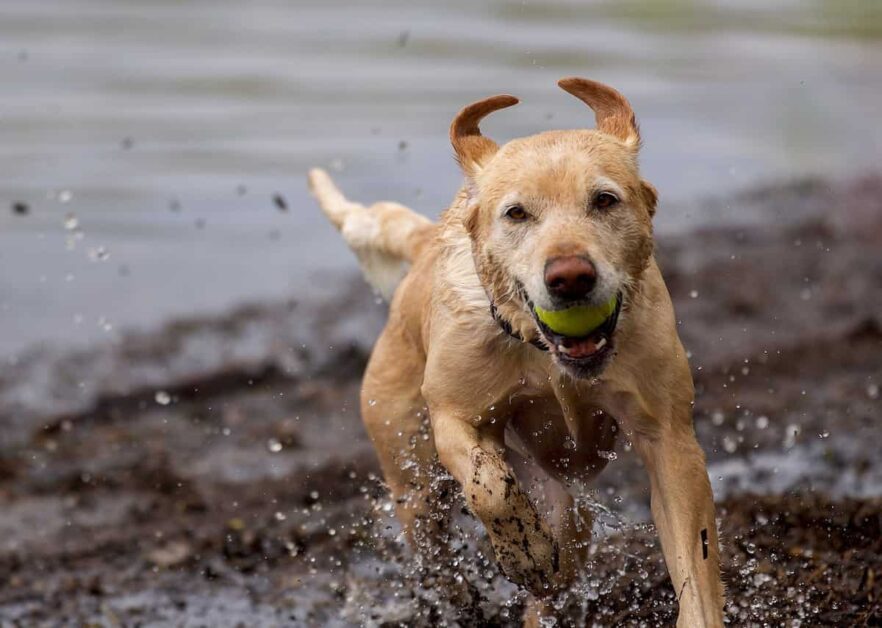Whether you’re a first-time breeder or awaiting a puppy from a breeder’s litter, the anticipation of puppies can be an exhilarating experience. Thankfully, the dog gestation period is shorter than in humans. But how long are labs pregnant?
To answer this, one must first grasp the canine reproductive cycle. Female dogs that haven’t been spayed experience heat roughly every six months. The heat cycle, spanning 18-to-21 days, consists of four unique stages.
Breeders utilize these stages to know of optimal breeding times for their dogs. We’ll cover how long are black labs pregnant, labrador pregnancies, and how to keep the mother and her offspring healthy and safe. We will give you tips on caring for your pregnant chocolate lab, and what steps you should take once the puppies are born.
The Reproductive Cycle In Dog Pregnancy: Sexual Maturity to Birth
The reproductive process in dogs is complex and consists of several vital stages. The first stage of the reproductive cycle in dogs is the heat cycle. It is when a female dog is fertile and can become pregnant. The heat cycle typically occurs every six months but can vary from dog to dog.
During this time, the female dog will produce pheromones attracting male dogs. You may notice pregnancy symptoms, like changes in her behavior, such as increased urination, restlessness, decreased appetite and a desire to escape or roam.
Be aware these signs may also indicate false phantom pregnancies. The heat cycle can make an unspayed female dog capable of becoming pregnant. Pregnancy in dogs lasts around 63 days and can result in a litter of puppies. The labrador gestation period can vary slightly. Monitoring the gestation period is essential to ensure she is healthy and comfortable.
The lab pregnancy length during labor can vary depending on the individual dog and how many puppies she will have. However, there are three stages of labor that every dog goes through. We’ll examine each stage more closely.

Stage One: how long are labs pregnant?
Restlessness, panting, and nesting behavior characterize the first stage of labor. It can last anywhere from 6 to 12 hours. During this stage, the cervix dilates, and contractions may begin. The contractions are usually mild and may not be noticeable to the dog owner.
This stage is also known as the preparatory phase, where the dog’s body is getting ready for the arrival of the labrador puppies. The dog may become more agitated and restless as the contractions become more frequent and intense.
Stage Two of labrador pregnancy
The second stage of labor can be highly intense and varies, ranging from 3 to 12 hours, depending on the litter size. During this stage, the dog’s body experiences a fully dilated cervix and strong contractions pushing the puppies out through the birth canal.
The dog may begin to strain, and you may notice a thin membrane protruding from the vulva, which is the amniotic sac. At this point, the expected puppies come out one by one. The lab mother may require rest between each delivery. Provide the dog a quiet, safe, and comfortable environment during this stage.
Lab pregnancies: Stage Three
The third and last stage of labor refers to the expulsion of the placenta. It can happen immediately after each puppy’s birth or after the entire litter’s delivery. This stage usually lasts 5 to 30 minutes and is characterized by the dog licking the puppy to clean it and stimulate breathing.
Expulsion of the placenta during pregnancy after each puppy and counting the number of placentas is crucial. Failure to expel a placenta can lead to a uterine infection that can be life-threatening.

How To Confirm Pregnancy For a Female Dog?
Veterinarians use several reliable methods to detect pregnancy. Here are some pregnancy testing processes
Hormone Health Tests for Pregnant Labrador
Hormone tests determine whether or not a dog is pregnant. When a dog becomes pregnant, its body produces a hormone called relaxin. One can detect this hormone by performing blood or urine tests as early as 22 days after mating.
A veterinarian can perform a hormone test to detect a dog’s blood cells or urine relaxin levels. They can do it by collecting blood samples and urine samples. If the test is positive for hormone relaxin, it strongly indicates that the dog is pregnant. Performing the test too early can result in a false negative outcome.
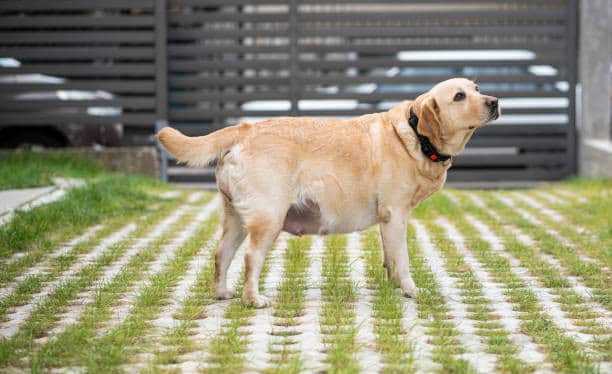
Palpation During lab gestation period
Another method to determine a pregnant bitch is palpation. It involves a veterinarian feeling the dog’s abdomen to detect developing puppies. Palpation is typically done around days 28-35 of the pregnancy when the puppies are large enough to be felt.
A veterinarian should only perform palpation, as incorrect handling of the unborn puppies could harm them or cause the dog to miscarry. This method may be inaccurate, especially in overweight or small dogs.
X-Ray
To determine pregnancy in dogs, docs use X-rays as well. This method typically occurs around 7 weeks of mating when the puppies’ skeletons have developed enough to be visible on an X-ray.
An X-ray can also help determine the number of puppies and their approximate size. One downside of using X-rays is exposing the developing puppies to radiation. While the amount of radiation is slight, minimizing the risk to the puppies and the pregnant female is essential.
Ultrasound
Ultrasound is a non-invasive method of determining pregnancy in dogs. This method uses high-frequency sound waves to create images of the developing puppies. It is possible to perform ultrasounds as early as day 21 of the pregnancy, making it one of the earliest detection methods.
This method is generally considered safe for both the mother and the puppies, as it does not expose them to harmful radiation. An ultrasound can also help identify potential complications or birth defects in puppy development.
If you believe your labrador is pregnant, consult a veterinarian. The vet can help you determine the best action for your dog’s health and well-being.
Gestation Period In Pregnant Dogs
The gestation for labradors refers to how long they are pregnant. Labrador retriever gestation period usually lasts around 63 days. The gestation period can range from 58 to 68 days.
Signs of Labor
As your dog’s due date approaches, you may notice signs that the mother dog is getting ready to give birth. Here are some indications to watch out for:
- Nesting behavior: The mother dog may start to create a nesting area, such as digging or scratching at blankets.
- Loss of appetite: Your dog may stop eating as much in the days leading up to labor.
- Restlessness: Your dog may seem more restless than usual, pacing or whining.
- Temperature drop: Your dog’s rectal temperature may drop by a degree or two in a day or two before labor begins.
lab pregnancy week by week
The birth of a new litter of puppies can be an exciting time for any pet owner. Just like human pregnancy, dog pregnancies are also a journey that requires care and attention. Knowing what to expect during weeks of pregnancy can help you provide the best care for the mother and her growing pups. Here is a week-by-week dog pregnancy calendar to guide you through the stages of pregnancy:
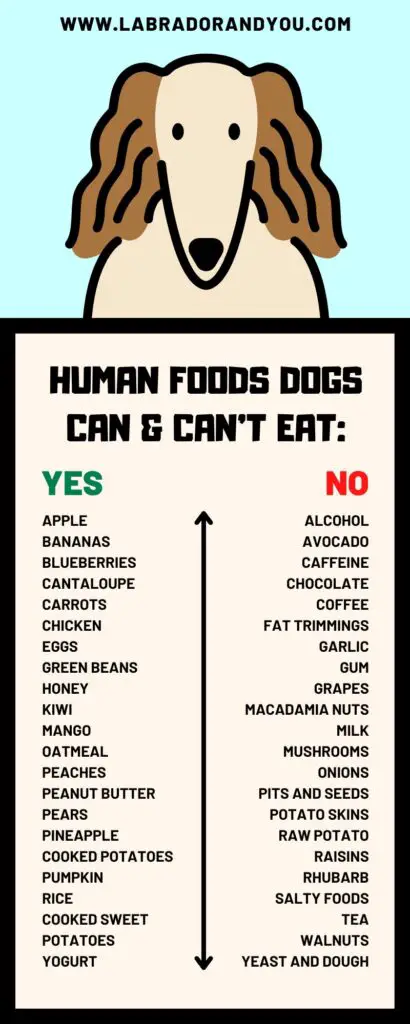
gestation for labradors: Week One (Early Stages)
The first week of your dog’s pregnancy begins with mating and fertilization. This week, the dog sperm of a male labrador will fertilize the female’s eggs, traveling down the fallopian tubes and implanting them into the uterus. This process typically happens within 48 – 73 hours of mating.
Week Two of labrador gestation
The embryos migrate to the uterine horns in the first month of dog pregnancy, typically on day 7. The embryos will undergo cell division and growth in the second week of pregnancy. The embryos will start to form into balls of cells, and by the end of the week, they will implant into the uterine lining. At this point, the embryos are around the size of a pinhead.
Week Three
The third week of pregnancy is crucial for the puppies’ development. Between days 15 and 21, your dog may experience mood swings, morning sickness, low dog’s appetite, and breast tissue growth. During this period, implantation occurs, and the embryos start to grow.
Week Four
Between days 22 and 28, you can feel the fetuses in the uterine horns, and they become visible through ultrasound after day 25. The fetuses’ spinal cords develop and grow facial features during this period. The uterus of your pregnant dog will soon be filled with fluids to safeguard the fetus. It will be several weeks before you can feel them again.
Week Five
Now you have a 1 month-pregnant labrador. Between days 29 and 35, the fetuses grow their sex organs and resemble real puppies. During this stage, the leg buds of the puppies elongate, and their toes begin to form.
Your dog’s belly will appear noticeably swollen as the pups occupy more space. Since there is less room for full meals, it is time to feed smaller meals more frequently.
Week Six
The puppies continue to grow, and their pigmentation starts to develop. Their eyes have lids that remain closed until approximately ten days after birth. Your dog may feel noticeably more uncomfortable and occasionally vomit due to the added pressure on her stomach. Moreover, you may observe clear fluid discharge from her vulva, which is a regular occurrence.
Week Seven
In the seventh week of dog pregnancy, the puppies are fully developed and growing in size in readiness for birth. You can feel them move inside your dog’s abdomen during this time.
Her breasts are also well developed and might contain some colostrum or “first milk.” Your dog will feel considerably tired and might begin searching for a spot to whelp. Therefore, it’s time to set up a whelping box.
Week Eight
During the eighth week of pregnancy, the dog enters the final stretch leading up to the birth. The puppies will be fully formed and begin positioning themselves for delivery. The mother may start to experience nesting behaviors, such as digging or seeking a quiet, comfortable space to give birth.
Week Nine
During the ninth week of pregnancy, the mother will go into labor and give birth to her healthy puppies. There will be visible contractions that can last several hours, and the mother will need your support and attention. After the puppies are born, monitoring their health and growth is essential to ensure their thriving.
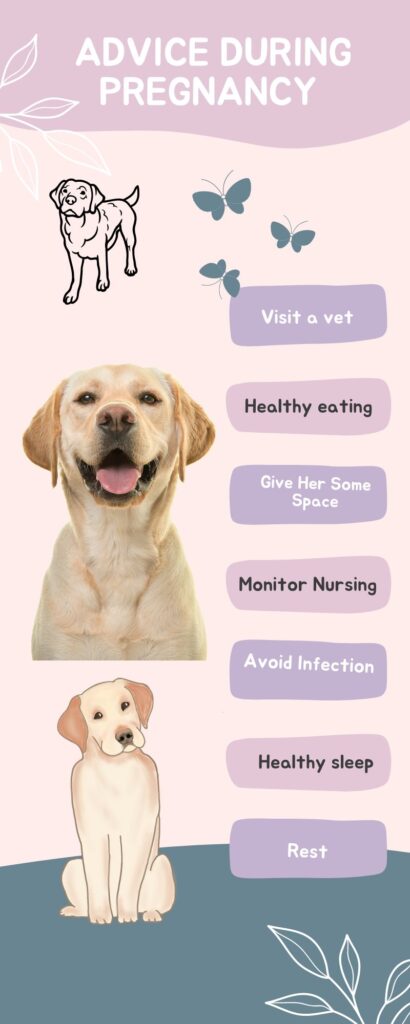
How To Care For A Dogs Pregnant With Puppies Inside?
Like humans, pregnant dogs require prenatal care and attention to ensure a healthy pregnancy and delivery. Here are some essential tips on how to care for a pregnant Labrador:
Avoid Infection
Pregnancy can weaken your dog’s immune system, leaving her more susceptible to infections. To prevent infections, you can take the following measures:
- Avoid exposing your dog to other animals that might be infected.
- Avoid exposing your dog to contaminated environments, such as dirty water or waste materials.
- Ensure your dog’s living area is clean and free of parasites like fleas and ticks.
- Take your dog to the vet to have blood drawn, as early detection of infections can prevent them from becoming more severe.
Pay Attention To Nutrition
Nutrition is critical during pregnancy, and your dog will gain weight. You must ensure that your dog gets the right nutrients for her health and the development of her puppies. Here are some nutrition tips during labrador’s pregnancy:
- Increase the food intake your dog eats gradually as the pregnancy progresses.
- Feed your dog a high-quality, balanced diet that contains all essential nutrients, including protein, fat, and carbohydrates.
- Offer your dog small, frequent meals throughout the day rather than a few large meals.
- Ensure your dog has access to fresh, clean water at all times.
Give Her Some Space
As your dog approaches the end of her pregnancy, she may become more irritable and need space to rest and prepare for delivery. It is completely normal. Here are some ways you can create a comfortable environment for your pregnant dog:
- Provide a quiet and comfortable place for your dog to rest away from other pets and children.
- Ensure your dog can access soft bedding and pillows to support her growing belly.
- Avoid moving or rearranging your dog’s living space, which may cause her undue stress.
Protect Against Mammary Gland Infection
Mammary gland infection, or mastitis, is a common complication during pregnancy and nursing. Here are some tips to prevent mammary gland infection:
- Keep your dog’s living area clean and free of bacteria
- Regularly inspect your dog’s mammary glands for any signs of redness, swelling, or discharge
- If you notice any signs of infection, take your dog to the vet immediately.
What To Feed The Pregnant Dog?
When feeding your pregnant dog, provide a balanced and nutritious diet with all the necessary nutrients. Here are some recommended foods for the pregnant black lab:
- High-quality commercial dog food specifically formulated for pregnant and nursing dogs.
- Cooked, lean meat like chicken or turkey.
- Cottage cheese, eggs, and other sources of protein.
- Vegetables like sweet potatoes, carrots, and green beans.
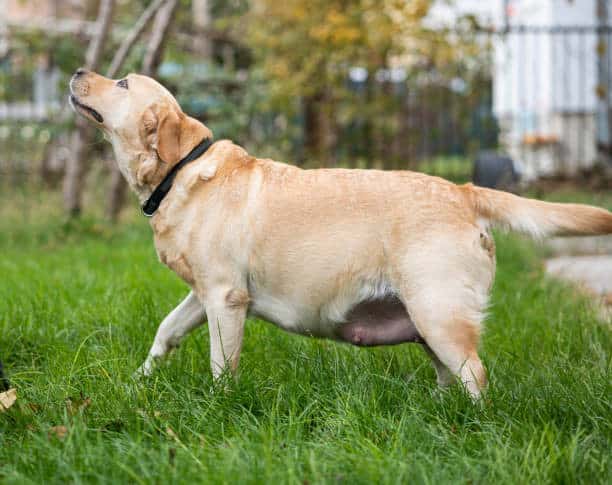
Factors Affecting Average Litter Size for Labradors
Several factors can affect the size of a Labrador’s litter. Let us explore four of the most critical factors impacting litter size.
Age
The age of the female labrador is a crucial factor. Typically, younger dogs tend to have fewer puppies than older ones. Their reproductive systems are still developing and may not be fully mature yet. In contrast, older dogs may have larger litters due to their more experienced reproductive systems.
Breed Size
The size of the Labrador breed can also play a role in litter size. Generally, larger dogs have larger litters, and smaller dogs have smaller litters. The size of the dog’s uterus and the number of eggs it can hold is directly related to the size of the dog. So, if you have a larger female Labrador, you can expect a larger litter of puppies.
Health And Nutrition
The health and nutrition of the female dog are critical to the size of the litter. A healthy, well-nourished female Labrador will likely have a larger litter than other dogs.
A balanced diet, regular exercise, and proper veterinary care can all help ensure that your dog is in good health and ready to breed. Additionally, it is essential to ensure that the female is free of any health issues, such as infections or reproductive disorders, which can negatively impact litter size.
Gene Pool Diversity
The gene pool of the Labrador breed can also affect litter size. Breeding two purebred dogs reduces the chances of having a larger litter. Conversely, breeding two genetically diverse dogs can increase the chances of having a larger litter. Introducing new genes into the gene pool makes the puppies more likely to inherit traits that can positively impact litter size.

Whelping Supply Checklist For Female Dogs:
Being prepared for the arrival of new puppies is essential for responsible dog owners. One of the most critical aspects of this preparation is ensuring you have all the necessary supplies for a successful whelping process. Here’s a checklist of essential items you’ll need:
- Whelping Boxes: A secure and comfortable space for your dog to give birth.
- Whelping Kit: Sterilized scissors, lubricant, thermometer, and other supplies for assisting in the delivery process.
- Towels and Blankets: Soft, clean towels and blankets to keep the puppies warm and dry.
- Heat Source: A heating pad or lamp provides a consistent source of warmth.
- Weighing Scale: A digital scale for weighing the puppies and monitoring their growth.
- Feeding Supplies: Milk replacers, bottles, and nipples for feeding the puppies.
- Cleaning Supplies: Gloves, disinfectant, and other supplies for keeping the whelping area clean.
- Emergency Supplies: Contact information for your vet, a thermometer, and other emergency supplies for unexpected situations.
By having all these essential supplies on hand, you can ensure a safe and smooth delivery for your dog and her new puppies.
Issues To Watch For After Your Dog Gives Birth
Keeping a close eye on your furry friend’s medical condition after giving birth is essential. Here are some issues to watch for:
Vaginal Discharge During Impending Birth
After giving birth, it’s normal for a dog to be discharged for a few weeks. The release could indicate infection if it becomes foul-smelling or excessive.
Fever
A fever is a sign of infection and can occur after giving birth. It’s essential to monitor your dog’s temperature and seek veterinary attention if it is consistently high.
Metritis (Inflamed Uterus)
An inflamed uterus can occur due to retained placenta or infection. Symptoms include lethargy, lack of appetite, and fever. Prompt veterinary care is necessary.
Eclampsia (Drop In Blood Calcium Levels)
A drop in blood calcium levels can cause seizures, restlessness, and panting. It’s essential to seek veterinary attention immediately if you suspect eclampsia.
Mastitis (Infected Breast Tissue)
Infected breast tissue can cause fever, pain, and swelling. Monitor your dog’s mammary glands regularly and seek veterinary care if you notice any abnormalities.
Agalactia (Not Producing Milk)
Not producing milk can occur due to stress or infection. Consult your veterinarian to determine the underlying cause and develop an appropriate treatment plan.

Postpartum Care When Your Dog Is Pregnant
The postpartum period can be stressful and demanding, requiring proper care weeks after delivery to ensure the mother’s and her offspring’s health and well-being. Here are some things to consider:
Keep Your Pregnant Lab On A High-Calorie Diet
After giving birth, your dog’s nutritional needs will increase. It’s essential to provide her with a high-quality, nutrient-dense diet to support her milk production and recovery.
Create A Private Space For Your Dog And The Puppy
Providing a calm, private space away from other animals and noise can help your dog feel relaxed and at ease. It will also provide a safe space for the puppies to nurse and rest.
Monitor Nursing
Keep a close eye on your dog’s nursing behavior to ensure that all puppies are getting enough milk and are nursing correctly. Contact your vet immediately if you notice signs of distress or difficulty nursing.
Call Your Vet If Your Dog Seems Sick or for weight gain
It’s essential to monitor your dog’s health during the postpartum period closely. Contact your vet immediately if you notice any signs of illness or discomfort, such as fever, lethargy, or loss of appetite.
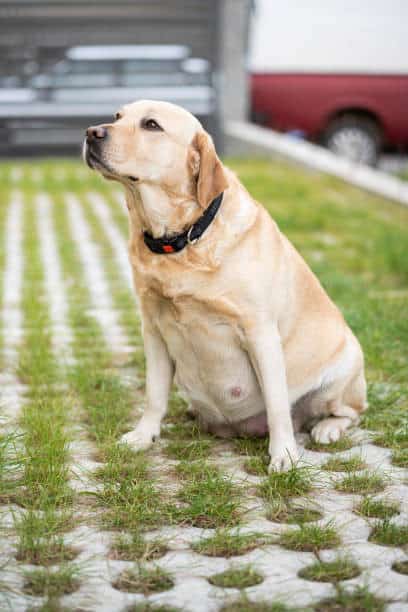
FAQ: how long are labs pregnant?
How Many Puppies Do Labs Usually Have In Their First Litter?
Labs usually have 6-8 puppies in their first litter. It can vary depending on the size and health of the mother.
How Long Can A Labrador Give Birth?
Labrador retrievers typically give birth in 6-12 hours, but it can take up to 24 hours. It’s essential to monitor the process for any issues.
Is It OK for A 1-Year-Old Dog To Get Pregnant?
One should not recommend a 1-year-old dog to get pregnant as their bodies are still developing. It will increase the risk of complications during pregnancy and birth.
At What Stage Does A Dog Look Pregnant?
A dog will begin to look visibly pregnant around 4-5 weeks into the pregnancy as their belly expands and its nipples enlarge.
What Are Early Signs Of Pregnancy for Dog?
Early outward signs of dog labor include nesting behavior, restlessness, loss of appetite, panting, and licking the genital area.
Do You Have To Tie Off Puppy Umbilical Cord?
To prevent infection, one should tie off the puppy’s umbilical cord with clean dental floss or thread about an inch from the puppy’s belly.
Does A Dog’s Water Break?
A dog’s water may break during labor, but it’s not always noticeable. If you notice fluid coming from your dog’s vulva, contact your vet simultaneously.
Do Dogs Cry Before Labor?
Dogs may cry or whine during labor due to the discomfort of contractions, but not all dogs exhibit this behavior. It’s essential to monitor them closely.
Author Profile

- Product Reviews Specialist and Cofounder
-
Labradors have an extraordinary capacity for love and companionship, and my mission is to help you unlock their full potential. Hi there! I'm Sarah, a proud contributor to Labradorandyou, the go-to online resource for all Labrador Retriever enthusiasts. As a lifelong owner and avid admirer of these remarkable dogs, I bring a wealth of knowledge and hands-on experience to our readers.
One of my strongest beliefs is in the power of positive reinforcement training. I'm truly passionate about helping our readers build strong, positive relationships with their Labradors. Whether you're a first-time owner or a seasoned Labrador enthusiast, I aim to provide you with the resources and guidance to cultivate a bond that will endure a lifetime.
Also by the author
-
 Lab-TypesJune 29, 2025Мостбет Регистрация На Официальном Сайте: Подробная Инструкция
Lab-TypesJune 29, 2025Мостбет Регистрация На Официальном Сайте: Подробная Инструкция
-
 Lab-TypesJune 28, 2025Sweet Silencio Vonseiten Sensible Enjoy: Erfahrungen Durch Echtgel Ece Home
Lab-TypesJune 28, 2025Sweet Silencio Vonseiten Sensible Enjoy: Erfahrungen Durch Echtgel Ece Home
-
 Lab-TypesJune 28, 2025Understanding Mostbet Login: A Complete User Guide
Lab-TypesJune 28, 2025Understanding Mostbet Login: A Complete User Guide
-
 Lab-TypesJune 28, 2025Топ 10 Онлайн Казино Рейтинг лучших Сайтов Для Игры На Деньги
Lab-TypesJune 28, 2025Топ 10 Онлайн Казино Рейтинг лучших Сайтов Для Игры На Деньги
